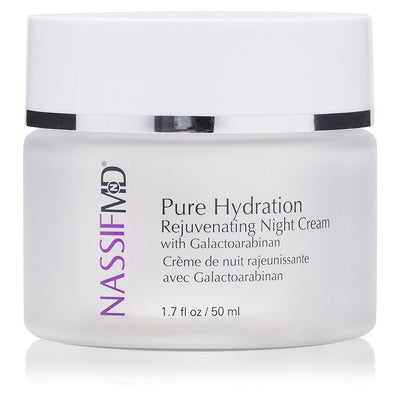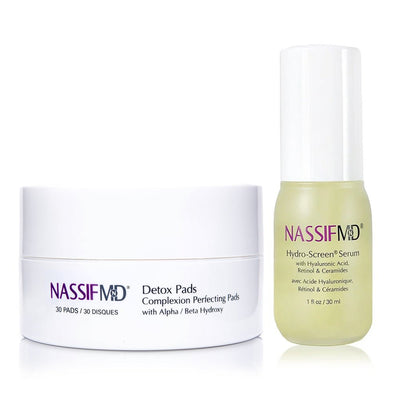Glycolic Acid – Experts Explain the Best AHA Acid Skincare
Glycolic Acid – Experts Explain the Best AHA Acid Skincare
Glycolic acid is a naturally occurring alpha hydroxy acid (AHA) with multiple benefits for skin health, from exfoliation to addressing hyperpigmentation. You’ll find glycolic acid in many at-home skincare products and skin spa treatments, like those offered at NassifMD® Medical Spas.
Today’s article will dive into glycolic acid benefits and how to use glycolic acid in your skincare routine. Plus, we’ll cover the best NassifMD® facial plastic surgeon skincare products with glycolic acid and synergistic ingredients.
Keep reading to learn more about:
- What does glycolic acid do?
- Glycolic acid skin benefits
- Glycolic acid uses
Let’s look at this exciting skincare ingredient!
What Does Glycolic Acid Do?
We’ll start with the basics: what is glycolic acid, and what is glycolic acid good for?
Glycolic acid falls in the category of alpha hydroxy acids (AHAs), along with lactic acid and citric acid. Beta hydroxy acids (BHAs), like salicylic acid, are other natural exfoliants you may be familiar with as ingredients in NassifMD® facial plastic surgeon skincare.
Glycolic acid is a naturally occurring acid from sugarcane and the smallest of the AHAs, allowing for deeper penetration in the skin and more effective results. In fact, glycolic acid is the most common AHA in skincare and dermatologic treatments, especially chemical peels.
As a skincare ingredient, glycolic acid has many functions, which we’ll cover more below. Its main action is as a chemical exfoliant, unclogging pores and allowing dead skin cells to slough off. The result is bright, fresh, hydrated, and retexturized skin.
Resurfaces Skin without Scrubbing
Because it’s an AHA exfoliant, glycolic acid aids in skin resurfacing without the need for scrubbing with a physical exfoliant, which can be abrasive. Glycolic acid works by loosening the bonds between dead skin cells and removing them from the skin’s surface, revealing the new, younger skin underneath.
Releases Dead Skin Cells as Chemical Exfoliant
Glycolic acid for skin exfoliation removes dead skin cells and impurities and cleans out the pores. It’s very potent and effective! Still, if you are new to glycolic acid or have sensitive skin, starting out slow is the best approach in order to avoid irritation. Too much exfoliation can harm the skin barrier, leading to dry, damaged skin.
Glycolic Acid Benefits
What does glycolic acid do for your skin? Alongside chemical exfoliation, glycolic acid has many benefits to the look and feel of your skin.
Benefits of glycolic acid include:
- Decreases the appearance of wrinkles and fine lines
- Promotes clear, glowing skin
- Evens skin texture and tone
Combats Wrinkles
Glycolic acid is an anti-aging ingredient. It improves skin wrinkles by promoting glycosaminoglycans and collagen production, which improves skin thickness and decreases wrinkles.
Reduces Appearance of Fine Lines
For the same reasons glycolic acid combats wrinkles, it also works to minimize fine lines. Additionally, glycolic acid helps protect the skin from sun damage by promoting skin rejuvenation, allowing for firmer, better-hydrated skin and the reduced appearance of fine lines.
Promotes Healthy, Glowing Skin
Exfoliation is the key to healthy, glowing skin. Beyond exfoliation and collagen stimulation, glycolic acid has additional benefits for the skin’s appearance. First, glycolic acid is a natural agent that reduces hyperpigmentation by suppressing melanin production. It helps to even out skin tone.
Second, research suggests glycolic acid plays a role in improving skin appearance. A clinical evaluation of a synergistic skincare formula including glycolic acid demonstrates improved luminosity.
Smooths Out Skin Texture
Glycolic acid and other AHAs are supportive for acne-prone skin. They help clear pores from sebum and bacteria, reducing inflammation and breakouts. Regardless of skin type, glycolic acid smooths skin texture because of its exfoliating properties.
How to Use Glycolic Acid
You’ll find glycolic acid in various at-home skincare products, including cleansers, toners, exfoliators, masks, and more. As you introduce glycolic acid, limit use to a couple of times per week and then increase with tolerance.
You may find that your skin does better with more frequent glycolic acid treatments in the warmer summer months and fewer in the dry winter months.
Start with a Glycolic Cleanser
A cleanser with glycolic acid is the perfect way to introduce this potent AHA to your skin because a cleanser doesn’t contact your skin for long. If you have sensitive skin, you can start with a spot treatment to be sure it’s a good fit.
NassifMD® Purifying Glycolic Facial Cleanser combines glycolic acid with soothing aloe and antioxidants to clean the skin effectively without drying it out. This formula:
- Deeply cleanses the skin
- Exfoliates and removes dead skin cells
- Reduces buildup and clears pores
- Reduces the appearance of fine lines and wrinkles
- Reveals smoother, radiant, younger skin
For a shower scrub you can use on your face and body, try NassifMD® Skin Perfecting Dual Action Body Scrub with Glycolic Acid. This facial plastic surgeon formulation combines glycolic acid with vitamin C to brighten and nourish the skin and Ecuadorian Ivory Palm as a gentle physical exfoliant to revitalize skin all over the body.
Graduate to Leave-On Glycolic Products
As your skin adjusts to glycolic acid, try a glycolic acid leave-on product such as NassifMD® Deco-Lift & Décolleté Firming & Lifting Complex. This serum firms and hydrates the neck and décolleté with a combination of Renovage peptide, vitamin C, glycolic acid, and other synergistic ingredients.
Use NassifMD® Deco-Lift & Décolleté Firming & Lifting Complex twice daily, morning and night. You can leave it on for the maximum softening, firming, toning and hydrating benefits.
Pair Exfoliation with Replenishment
NassifMD® facial plastic surgeon skincare is formulated to the four key markers of healthy, youthful skin: hydration, even skin tone, smooth texture, and firmness. To achieve these goals.
Dr. Nassif focuses on formulas that work synergistically to:
- Hydrate
- Exfoliate
- Nourish
- Protect
Exfoliation isn’t meant to be the only skincare tool used in isolation. After exfoliating, you always need to add nourishment and moisture.
Always Moisturize after Using Glycolic Acid Products
Follow glycolic acid products with skin-loving nutrients. NassifMD® Hydro-Screen Serum is the perfect fit for hydration and nourishment. Lock in the hydration with NassifMD® Pure Hydration Rejuvenating Night Cream or NassifMD® Soft Focus Hydrating Day Cream.
When using glycolic acid, add daily SPF support to your skincare routine to protect sensitive, exfoliated skin from the sun. NassifMD® Protect and Hydrate and NassifMD® Simply Hydration are our must-haves for daily use.
Glycolic Acid Uses
As mentioned, glycolic acid is found in various products, such as cleansers, toners, masks, and peels. However, you don’t need to use it throughout your skincare routine. Pick one or two glycolic acid products to experiment with in your routine, and then use other products with beneficial active ingredients to hydrate, nourish, and protect your skin.
The best glycolic acid options are:
- NassifMD® Purifying Glycolic Facial Cleanser
- NassifMD® Skin Perfecting Dual Action Body Scrub with Glycolic Acid
- NassifMD® Deco-Lift & Décolleté Firming & Lifting Complex
Face Wash
Start with a face wash such as NassifMD® Purifying Glycolic Facial Cleanser or a glycolic acid body wash like NassifMD® Skin Perfecting Dual Action Body Scrub with Glycolic Acid as a gentle introduction to glycolic acid. Be sure to pair glycolic acid with hydrating ingredients and follow with the rest of your skincare routine.
Skin Toner
After cleansing, use a gentle toner to help restore the skin’s balance. NassifMD® Pure Hydration Replenishing Toner works well after AHA products.
Chemical Peel
Chemical peels use higher concentrations of glycolic acid than you’ll find in AHA serums or other at-home products. Chemical peels and other cosmetic treatments are available at NassifMD® Medicals Spas in Beverly Hills, USA and the UK.
Face Mask
At-home face masks are another way to utilize hydroxy acids at lower concentrations than you’ll find in professional chemical peels. NassifMD® Overnight Illuminating Masque contains lactic acid and azelaic acid to gently exfoliate, while nourishing and restoring the skin overnight.
Glycolic acid is an effective, natural exfoliating agent that helps minimize lines and wrinkles, brighten, smooth, and improve skin texture and tone. It’s an ingredient in various skincare products and clinical skin treatments. However, a great place to start is with NassifMD® Purifying Glycolic Facial Cleanser, which has incredible benefits and is suitable for all skin types.
References
- Sharad J. (2013). Glycolic acid peel therapy - a current review.Clinical, cosmetic and investigational dermatology, 6, 281–288.
- Tang, S. C., & Yang, J. H. (2018). Dual Effects of Alpha-Hydroxy Acids on the Skin.Molecules (Basel, Switzerland), 23(4), 863.
- González-Molina, V., Martí-Pineda, A., & González, N. (2022). Topical Treatments for Melasma and Their Mechanism of Action.The Journal of clinical and aesthetic dermatology, 15(5), 19–28.
- Houshmand E. B. (2021). Effect of glycolic acid, phytic acid, soothing complex containing Emulsion on Hyperpigmentation and skin luminosity: A clinical evaluation.Journal of cosmetic dermatology, 20(3), 776–780.
- Liu, H., Yu, H., Xia, J., Liu, L., Liu, G. J., Sang, H., & Peinemann, F. (2020). Topical azelaic acid, salicylic acid, nicotinamide, sulphur, zinc and fruit acid (alpha-hydroxy acid) for acne.The Cochrane database of systematic reviews, 5(5), CD011368.






















